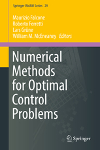- About MAA
- Membership
- MAA Publications
- Periodicals
- Blogs
- MAA Book Series
- MAA Press (an imprint of the AMS)
- MAA Notes
- MAA Reviews
- Mathematical Communication
- Information for Libraries
- Author Resources
- Advertise with MAA
- Meetings
- Competitions
- Programs
- Communities
- MAA Sections
- SIGMAA
- MAA Connect
- Students
- MAA Awards
- Awards Booklets
- Writing Awards
- Teaching Awards
- Service Awards
- Research Awards
- Lecture Awards
- Putnam Competition Individual and Team Winners
- D. E. Shaw Group AMC 8 Awards & Certificates
- Maryam Mirzakhani AMC 10 A Awards & Certificates
- Two Sigma AMC 10 B Awards & Certificates
- Jane Street AMC 12 A Awards & Certificates
- Akamai AMC 12 B Awards & Certificates
- High School Teachers
- News
You are here
Numerical Methods for Optimal Control Problems

Publisher:
Springer
Publication Date:
2019
Number of Pages:
268
Format:
Hardcover
Series:
Springer INdAM Series (Book 29)
Price:
119.99
ISBN:
978-3-030-01959-4
Category:
Collection
[Reviewed by , on ]
Bill Satzer
12/8/2019
This book is focused on optimal control theory, which is the determination of control strategies for complex dynamical systems that optimize their performance. The eleven papers in this volume were presented at a workshop on numerical methods for optimal control in 2017.
The overall goal of the workshop was to compare techniques of several different types for achieving optimal control including open-loop optimization, nonlinear and dynamic programming, and model predictive control. The idea was to gather experts from various communities in control theory and numerical analysis and give them an opportunity to identify opportunities to identify and integrate existing strategies with new numerical methods. The numerical computation of optimal control strategies is a problem of high complexity. Consequently, the participants gave particular attention to tools for high-dimensional problems that offer means of preserving robustness while avoiding the “curse of dimensionality”.
Applications of optimal control theory now range from problems of industrial process control to traffic flow optimization, efficient handling of renewable resources, management of financial markets, and large-scale economic planning. Many of these environments are now modeled as stochastic systems, so optimal control theory has expanded its range of tools to include methods of stochastic dynamical systems and multi-agent systems. The issues of the curse of dimensionality and the need to ensure the robustness of the algorithms become serious challenges when the complexity of the optimization grows exponentially with the number of state variables.
While improvements in algorithms for optimal control can be expected to provide some foundations for future development, real-life applications will demand considerable improvements in the efficiency and reliability of associated numerical methods. The papers in this collection primarily draw on the broad range of numerical tools applicable to this class of problems, although this is always in the context of optimal control.
One representative paper from this collection looks at the efficient heating of buildings using optimal control of heat convection. This leads to a class of linear parabolic convection-diffusion equations that model the temperature inside a room, which is constrained to lie within a certain range. The associated numerical method uses proper orthogonal decomposition to reduce the dimensions of the problem. Another paper considers a bi-level optimization of traffic flow designed to minimize congestion on road networks. This aims to optimize the distribution of the cars by identifying an optimal speed for each car in the system while minimizing the overall travel time.
Several papers are focused on technical aspects for the solution of optimal control problems without reference to specific applications. These include topics like order reduction for the algebraic Ricatti equation and an adaptive eigenvector method for continuous-time optimal control problems.
All the papers require at least a moderate level of expertise in optimal control theory. A background in numerical analysis is also necessary. Many numerical methods are in play here – especially ones involving partial differential equations - and few of them are elementary. This is clearly a book aimed at experts, and there are no concessions to neophytes.
Bill Satzer (bsatzer@gmail.com), now retired from 3M Company, spent most of his career as a mathematician working in industry on a variety of applications ranging from speech recognition and network modeling to optical films and material science. He did his PhD work in dynamical systems and celestial mechanics.
See the publisher's web page.
- Log in to post comments




